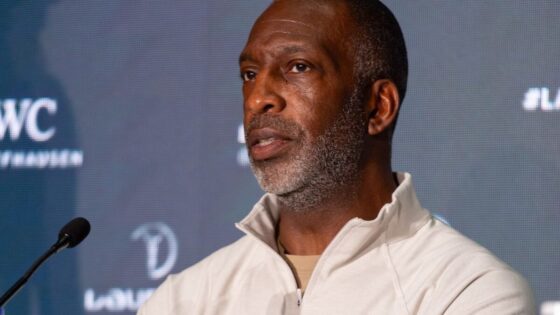The motive behind Michael Johnson’s Grand Slam track’s mysterious late-night Zoom call is finally out, and it’s the news no track fan wanted to hear. For days, athletes, agents, and fans were left guessing after a sudden invite to a post-Diamond League Zoom meeting dropped into inboxes with no real explanation. Speculation was everywhere: Was it about prize money? A new partnership? A surprise announcement for LA? The tension built, and now, the truth is out.
Michael Johnson’s ambitious Grand Slam Track has officially canceled its final meet in Los Angeles, which was set for June 28–29 at UCLA. The Zoom call confirmed fears that had been growing behind the scenes despite a strong start and major backing, the league had been facing major challenges. Sources cite a mix of problems: poor ticket sales, weak sponsorships, broadcasting gaps, a bad lease deal with UCLA, and even city unrest tied to anti-ICE protests. It’s a cocktail of chaos that brought what was supposed to be the grand finale to a grinding halt.
The LA cancellation lands as a major blow for a league that promised so much. Johnson, a four-time Olympic gold medalist, had raised over $30 million in funding and set out to shake up the track world with a tennis-style circuit, featuring big money ($100,000 per race win) and a compact, high-energy format. Meets in Kingston, Miami, and Philadelphia showcased top-tier talent like Gabby Thomas, Matthew Hudson-Smith, and Kenny Bednarek. But even those thrilling races couldn’t distract from the empty stands and financial cracks.
EXCLUSIVE: Grand Slam Track has canceled its Los Angeles Slam, originally set for June 28-29, FOS has learned.
After raising more than $30 million, Michael Johnson’s startup track circuit has a meeting today to discuss the future of the company.
Story by @KaplanSportsBiz
— Front Office Sports (@FOS) June 12, 2025
For athletes, this isn’t just about one meet being cut; it’s about trust. Many now wonder whether they’ll be paid in full, what happens to rankings, and whether the league can survive into a second season. Michael Johnson’s team insists the shutdown doesn’t mean the end, with whispers of a strategic investor possibly reshaping the future, but until something concrete is announced, the track world is left hanging. One thing’s for sure: fans were ready. Athletes showed up. But turning Grand Slam Track into a lasting legacy? That’s still a race far from the finish line. And judging by the reactions, fans weren’t just surprised, they were stunned.
Fans left in the dark as Michael Johnson’s Grand Slam Track faces backlash
One fan said it best: “Too soon .” Another chimed in, “My jaw is on the floor.” The shock online is real, but honestly, Noah Lyles saw this coming a mile away. From Kingston’s empty seats to Philly’s abrupt schedule slash, the red flags weren’t subtle. In Jamaica, steep ticket prices ($60 a day) priced out the very fans who live and breathe track. Miami had a stronger vibe, but without headline names like Lyles and Sha’Carri, it lacked that star-power sizzle. And Philly? Hotels were pricier than the flights, and just weeks out, the event was suddenly chopped from three days to two. The track was on fire, but the stands? Quiet. And not a single major sponsor in sight.
Lyles wasn’t just sitting Michael Johnson’s league out for fun; he’d done the math. “If a tree falls in the woods and nobody’s there to see it, did it really fall?” he asked, slamming the league’s visibility problem. On Cam Newton’s podcast, he laid it bare: the money offered was weak, sure, but the real issue was deeper, no storytelling, no branding, no growth. “Where’s the watch sponsor? Where’s the storytelling?” he pressed. For Lyles, it was never just about a check; it was about building a legacy.
Another fan nailed the sentiment: “The obvious red flag wasn’t even cutting Philly to two days—it was the lack of sponsors on the broadcast. I just hope everyone got paid for the first three events.” That’s the thing: while Philly delivered some high-energy moments, the cracks were still showing. The 2025 Philadelphia Slam, held May 31 to June 1 at Franklin Field, was originally planned as a three-day spectacle. But just two weeks before showtime, it got slashed down, compressing all the action into a packed Saturday-Sunday lineup with 12 races per day. Why?
Organizers cited “fan and athlete feedback,” saying the original format had too much downtime, dull pacing, and lacked punch. Michael Johnson framed the change as making it “high-octane and intense.” And honestly? The crowd showed up, around 10,000 each day, with the home stretch nearly full. Still, not everything was a win. Long-distance runners took a hit: the 5,000m was axed, the prize money was slashed in half ($50K instead of $100K), and some athletes had to adjust on the fly.
The two-day pivot may have helped the broadcast flow smoother and cut filler, but the last-minute decision left fans scrambling for refunds and wondering what else might get cut next.
Another fan summed it up perfectly: “Man. That is a huge bummer. It felt like Grand Slam Track was really gaining momentum after the excellent Philly meet. I do hope this is not the end for the league.” Another added, “The silence from the organizers is LOUD! I had a bad feeling after that last-minute Zoom call.” It’s a feeling that echoes across the fanbase. Just when it seemed like Michael Johnson’s Grand Slam Track was finding its groove, especially after a thrilling Philly stop, questions are now swirling about its future, and whether the cracks were showing all along.
The journey started in Kingston (Apr 4–6), where the debut leg at Jamaica’s National Stadium kicked off with excitement but an underwhelming turnout. Despite being in a nation that lives and breathes track, ticket prices didn’t align with local fans’ wallets. The result? Sparse stands, especially on Day 1. Then came Miami (May 2–4), and the vibe changed. The Ansin Sports Complex saw a spike in attendance and engagement, thanks to major headliners like Kenny Bednarek and Sydney McLaughlin-Levrone dropping world-class times. Miami felt like a momentum shift, fast, fun, and flashy.
But it was Philadelphia (May 31–June 1) that felt like the league’s breakout moment. Held at Franklin Field, the meet drew over 10,000 fans per day, producing 11 stadium records and several world-leading marks. Fans loved the pacing, the broadcast was clean and tight, and every race felt like it mattered. As one Redditor put it: “No marathon-length meet, no dead air..just fire racing start to finish.” That’s exactly what Michael Johnson was going for. The Grand Slam’s mix of elite “Racers” vs rotating “Challengers,” and a focus on broadcast-first storytelling made it a fresh alternative to the traditional Diamond League. But now, with financial uncertainty, sponsor silence, and a cancelled final leg, fans are left wondering: was this the beginning of a new era, or just a flashy sprint that burned out too fast?
The post Track and Field Community Distressed as Shocking Announcement Made Over Michael Johnson’s Grand Slam Track appeared first on EssentiallySports.



